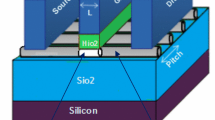Abstract
This research work explores various circuit-level design techniques to identify the best technique suitable for low power circuit design. To establish a proper performance comparison, reported techniques are implemented in a transmission gate-based carry skip adder circuit @ 22-nm technology node. Results obtained demonstrate that the multi-threshold CMOS technique offers the best performance under the given conditions. Further, a novel modified hybrid circuit design technique is also proposed in this paper. To validate the proposed design technique, performance metrics of the carry-skip adder circuit implemented using the proposed hybrid technique and other low power circuit design techniques are compared. Obtained results establish that the proposed technique offers improvement in terms of propagation delay (TP), average power dissipation (PAVG), power delay product (PDP) and leakage power (LP), when compared with its counterpart at a supply voltage of 0.4 V.














Similar content being viewed by others
References
Alioto M, Palumbo G (2002) Analysis and comparison: full adder block in submicron technology. IEEE Trans Very Large Scale Integr VLSI Syst 10(6):806–823. https://doi.org/10.1109/CIMSim.2013.39
Anjana R, Somkuwar AK (2013) Analysis of sub threshold leakage reduction techniques in deep sub micron regime for CMOS VLSI circuits. In: 2013 International conference on emerging trends in VLSI, embedded system, nano electronics and telecommunication system, ICEVENT 2013. https://doi.org/10.1109/ICEVENT.2013.6496576
Bahadori M, Kamal M, Afzali-Kusha A, Pedram M (2016) High-speed and energy-efficient carry skip adder operating under a wide range of supply voltage levels. IEEE Trans Very Large Scale Integr VLSI Syst 24(2):421–433. https://doi.org/10.1109/TVLSI.2015.2405133
Chandrakasan AP, Brodersen RW (1995) Minimizing power consumption in digital CMOS circuits. Proc IEEE 83(4):498–523. https://doi.org/10.1109/5.371964
Chandrakasan AP, Bowhill WJ, Fox F (2000) Design of high-performance microprocessor circuits, 1st edn. Wiley-IEEE Press, Hoboken
Chiwande SS, Dakhole PK (2012) VLSI design of power efficient carry skip adder using TSG & Fredkin reversible gate. In: 2012 International conference on devices, circuits and systems, ICDCS 2012, pp 370–373. https://doi.org/10.1109/ICDCSyst.2012.6188788
Deepika KG, Priyadarshini KM, Solomon Raj KD (2013) Sleepy keeper approach for power performance tuning in VLSI design. Int J Electron Commun Eng 6(1):17–28. http://www.i-scholar.in/index.php/Ijece/article/view/39198. Accessed Aug 2017
Deng J, Wong HSP (2007a) A compact SPICE model for carbon-nanotube field-effect transistors including nonidealities and its application—part II: full device model and circuit performance benchmarking. IEEE Trans Electron Devices 54(12):3195–3205. https://doi.org/10.1109/TED.2007.909030
Deng J, Wong HSP (2007b) A compact SPICE model for carbon-nanotube field-effect transistors including nonidealities and its application—part I: model of the intrinsic channel region. IEEE Trans Electron Devices 54(12):3195–3205. https://doi.org/10.1109/TED.2007.909043
Dwivedi AK, Islam A (2015) Nonvolatile and robust design of content addressable memory cell using magnetic tunnel junction at nanoscale regime. IEEE Trans Magn 51(12):1–13
Dwivedi AK, Urma KA, Kumar A, Islam A (2014) Robust design of CNFET based buffered delay model and microwave pulse generator. In: 2014 International conference on devices, circuits and communications, ICDCCom 2014—proceedings. https://doi.org/10.1109/ICDCCom.2014.7024742
Dwivedi AK, Urma KA, Islam A (2015) Trigger pulse generator using proposed buffered delay model and its application. Act Passive Electron Compon 920508:1–9
Dwivedi AK, Guduri M, Islam A (2018) Performance enhancement of full adder circuit: current mode operated majority function based design. In: Proceedings of the second international conference on computational intelligence and informatics. Springer, pp 569–578
Hanchate N, Ranganathan N (2004) LECTOR: a technique for leakage reduction in CMOS circuits. IEEE Trans Very Large Scale Integr VLSI Syst 12(2):196–205. https://doi.org/10.1109/TVLSI.2003.821547
Imran A, Hasan M, Islam A, Abbasi SA (2012) Optimized design of a 32-nm CNFET-based. IEEE Trans Nanotechnol 11(6):1100–1109
Kao JT, Chandrakasan AP (2000) Dual-threshold voltage techniques for low-power digital circuits. IEEE J Solid State Circuits 35(7):1009–1018. https://doi.org/10.1109/4.848210
Kawaguchi Hiroshi, Nose Koichi, Sakurai Takayasu (2000) Super cut-off CMOS (SCCMOS) scheme for 0.5-V supply voltage with picoampere stand-by current. IEEE J Solid State Circuits 35(10):1498–1501. https://doi.org/10.1109/4.871328
Khatibzadeh AA, Raahemifar K (2003) A 14-transistor low power high-speed full adder cell. In: Electrical and computer engineering, 2003. IEEE CCECE 2003. Canadian conference on, pp 163–166
Kim KK, Kim YB, Choi K (2011) Hybrid CMOS and CNFET power gating in ultralow voltage design. IEEE Trans Nanotechnol 10(6):1439–1448. https://doi.org/10.1109/TNANO.2011.2168236
Kumar M, Arya SK, Pandey S (2012) A new low power single bit full adder design with 14 transistors using novel 3 transistors XOR gate. Int J Model Optim 2(4):544–548. https://doi.org/10.7763/IJMO.2012.V2.179
Lin S, Kim YB, Lombardi F (2011) CNTFET-based design of ternary logic gates and arithmetic circuits. IEEE Trans Nanotechnol 10(2):217–225. https://doi.org/10.1109/TNANO.2009.2036845
Madani NM, Tavassoli B, Behnam A, Afzali-Kusha A (2004) Study of super cut-off CMOS technique in presence of the gate leakage current. In: Proceedings the 16th international conference on microelectronics 2004 ICM 2004, pp 24–27. https://doi.org/10.1109/ICM.2004.1434196
Mutoh S, Aoki T, Matsuya Y, Shigematsu S, Yamada J (1995) 1-V power supply high-speed digital circuit technology with multithreshold-voltage CMOS. IEEE J Solid State Circuits 30(8):847–854. https://doi.org/10.1109/4.400426
Predictive Technology Model (PTM) 2011 (2011) http://ptm.asu.edu/. Accessed June 2012
Rabeay JM, Chandrakasan A, Nikolic B (1996) Digital integrated circuits. In: Sodini CG, Series Editor. Prentice Hall Electronics and VLSI Series. Prentice Hall, Upper Saddle River
Roy K (1998) Leakage power reduction in low-voltage CMOS designs. In: Electronics, circuits and systems, 1998 IEEE international conference on, vol 2, pp 167–173. IEEE. https://doi.org/10.1109/ICECS.1998.814856
Sathyaki K, Paily R (2007) Leakage reduction by modified stacking and optimum ISO input loading in CMOS devices. In: 15th International Conference on Advanced Computing and Communications (ADCOM 2007), pp 220–227. https://doi.org/10.1109/ADCOM.2007.85
Schulte MJ, Chirca K, Glossner J, Wang H, Mamidi S, Balzola P, Vassiliadis S (2004) A low-power carry skip adder with fast saturation. Proc Int Conf Appl Specif Syst Archit Process. https://doi.org/10.1109/ASAP.2004.1342477
Author information
Authors and Affiliations
Corresponding author
Additional information
Publisher's Note
Springer Nature remains neutral with regard to jurisdictional claims in published maps and institutional affiliations.
Rights and permissions
About this article
Cite this article
Guduri, M., Dwivedi, A.K., Majumder, S. et al. An efficient circuit-level power reduction technique for ultralow power applications. Microsyst Technol 25, 1689–1697 (2019). https://doi.org/10.1007/s00542-018-4103-z
Received:
Accepted:
Published:
Issue Date:
DOI: https://doi.org/10.1007/s00542-018-4103-z




